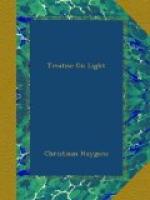Mr. Bartholinus, in his treatise of this Crystal, puts at 101 degrees the obtuse angles of the faces, which I have stated to be 101 degrees 52 minutes. He states that he measured these angles directly on the crystal, which is difficult to do with ultimate exactitude, because the edges such as CA, CB, in this figure, are generally worn, and not quite straight. For more certainty, therefore, I preferred to measure actually the obtuse angle by which the faces CBDA, CBVF, are inclined to one another, namely the angle OCN formed by drawing CN perpendicular to FV, and CO perpendicular to DA. This angle OCN I found to be 105 degrees; and its supplement CNP, to be 75 degrees, as it should be.
[Illustration]
To find from this the obtuse angle BCA, I imagined a sphere having its centre at C, and on its surface a spherical triangle, formed by the intersection of three planes which enclose the solid angle C. In this equilateral triangle, which is ABF in this other figure, I see that each of the angles should be 105 degrees, namely equal to the angle OCN; and that each of the sides should be of as many degrees as the angle ACB, or ACF, or BCF. Having then drawn the arc FQ perpendicular to the side AB, which it divides equally at Q, the triangle FQA has a right angle at Q, the angle A 105 degrees, and F half as much, namely 52 degrees 30 minutes; whence the hypotenuse AF is found to be 101 degrees 52 minutes. And this arc AF is the measure of the angle ACF in the figure of the crystal.
[Illustration]
In the same figure, if the plane CGHF cuts the crystal so that it divides the obtuse angles ACB, MHV, in the middle, it is stated, in Article 10, that the angle CFH is 70 degrees 57 minutes. This again is easily shown in the same spherical triangle ABF, in which it appears that the arc FQ is as many degrees as the angle GCF in the crystal, the supplement of which is the angle CFH. Now the arc FQ is found to be 109 degrees 3 minutes. Then its supplement, 70 degrees 57 minutes, is the angle CFH.
It was stated, in Article 26, that the straight line CS, which in the preceding figure is CH, being the axis of the crystal, that is to say being equally inclined to the three sides CA, CB, CF, the angle GCH is 45 degrees 20 minutes. This is also easily calculated by the same spherical triangle. For by drawing the other arc AD which cuts BF equally, and intersects FQ at S, this point will be the centre of the triangle. And it is easy to see that the arc SQ is the measure of the angle GCH in the figure which represents the crystal. Now in the triangle QAS, which is right-angled, one knows also the angle A, which is 52 degrees 30 minutes, and the side AQ 50 degrees 56 minutes; whence the side SQ is found to be 45 degrees 20 minutes.
In Article 27 it was required to show that PMS being an ellipse the centre of which is C, and which touches the straight line MD at M so that the angle MCL which CM makes with CL, perpendicular on DM, is 6 degrees 40 minutes, and its semi-minor axis CS making with CG (which is parallel to MD) an angle GCS of 45 degrees 20 minutes, it was required to show, I say, that, CM being 100,000 parts, PC the semi-major diameter of this ellipse is 105,032 parts, and CS, the semi-minor diameter, 93,410.




